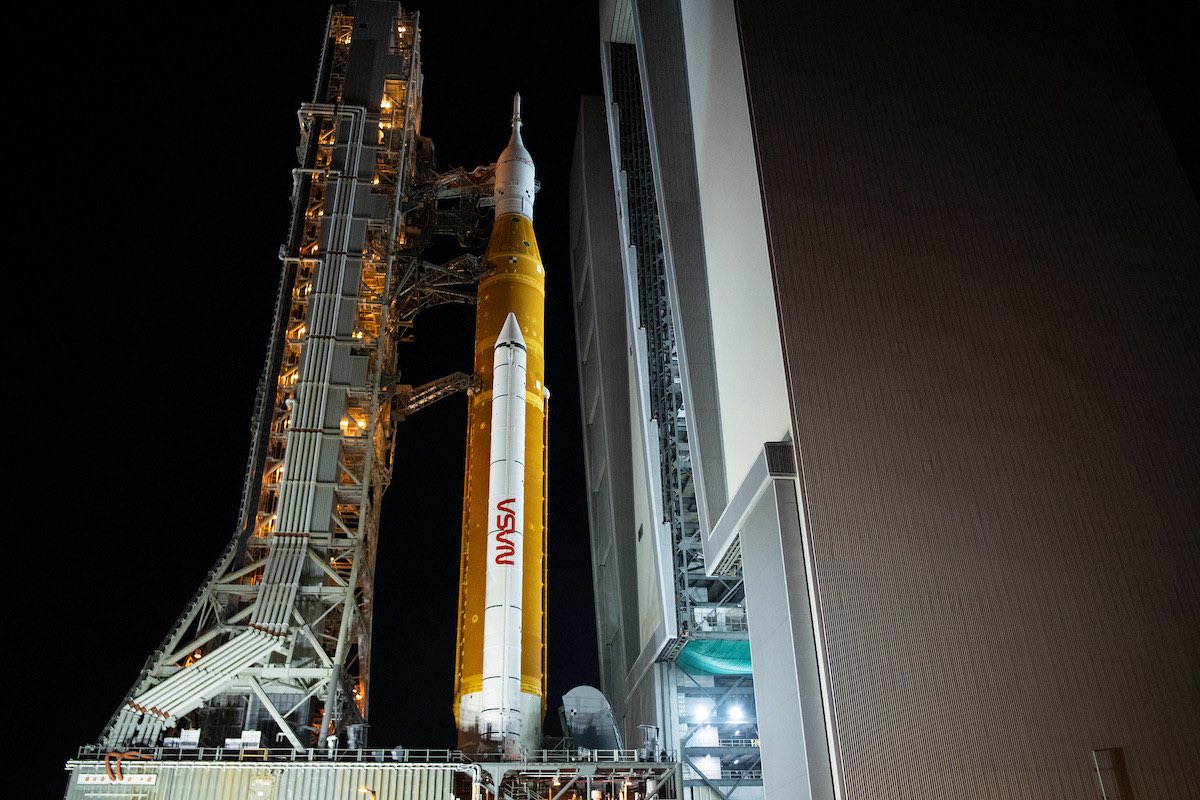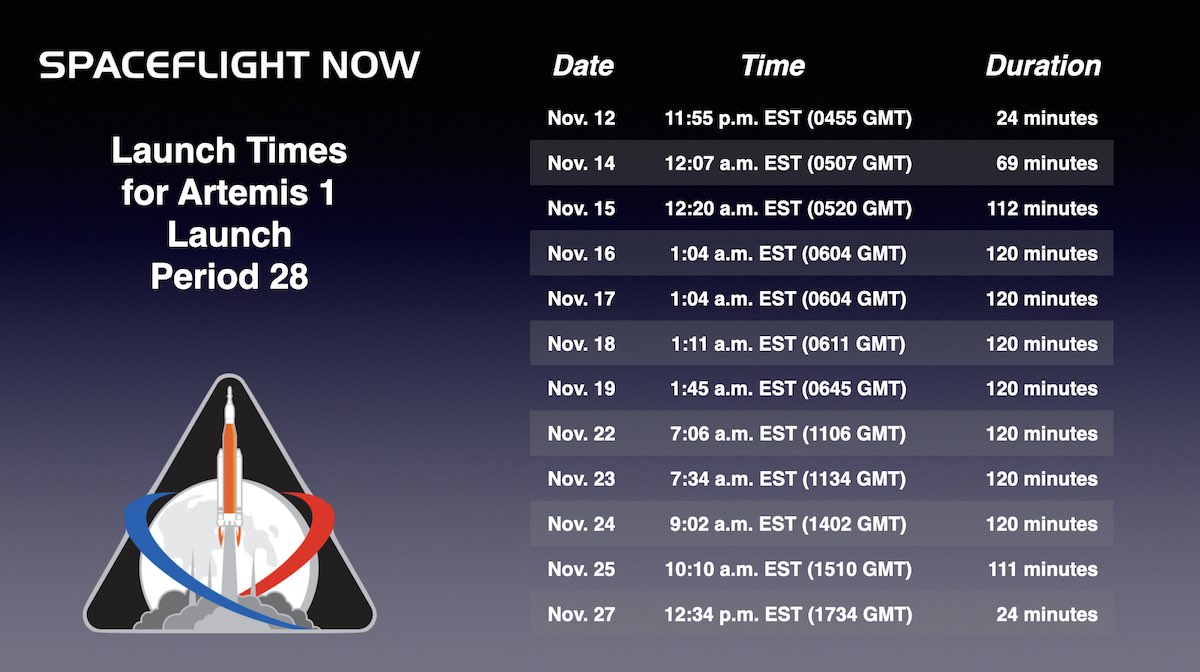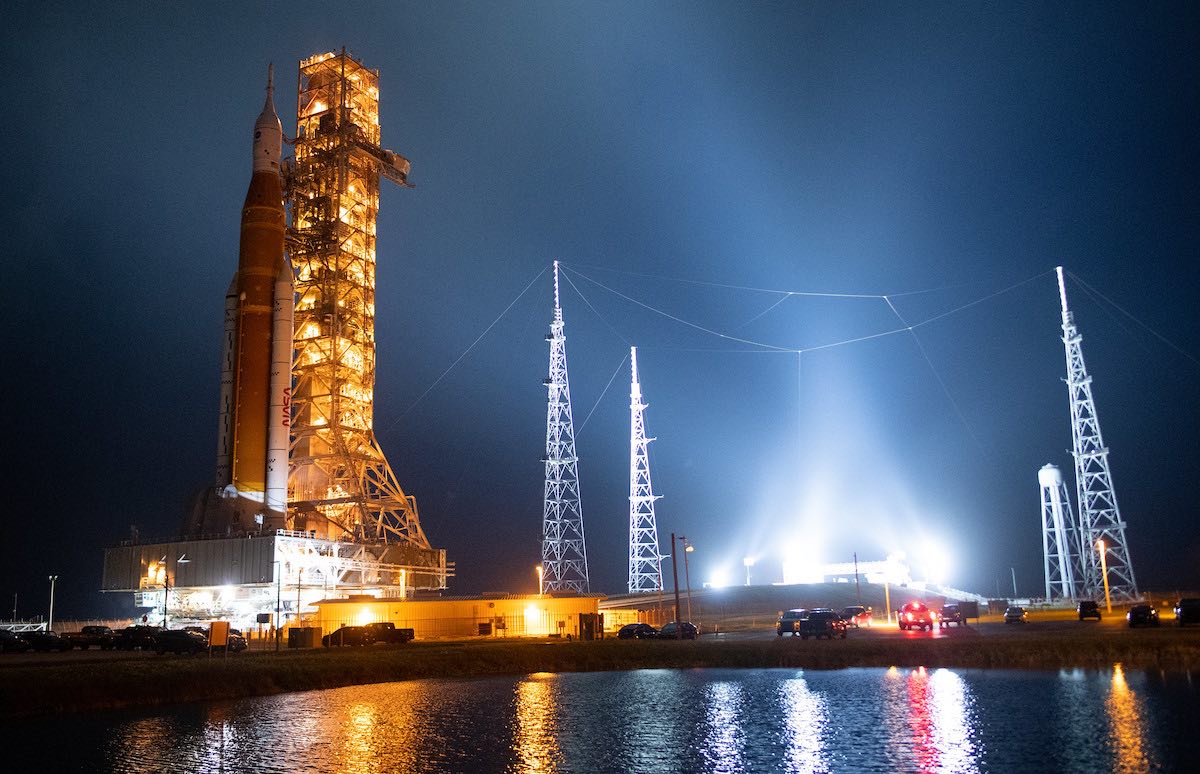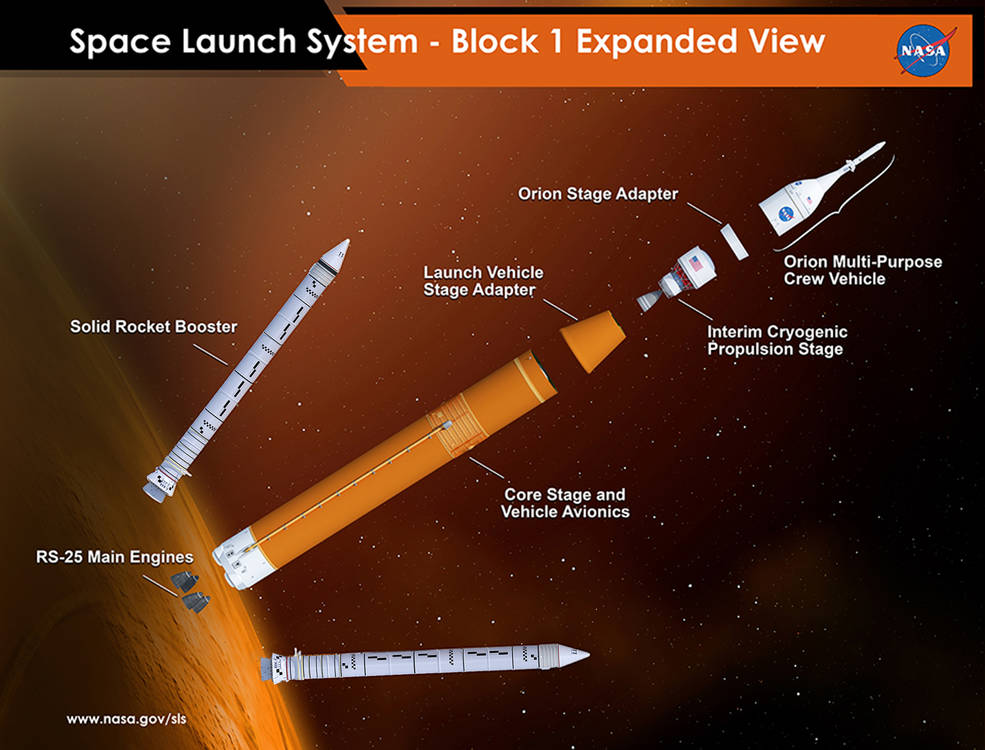Space News & Blog Articles
NASA’s Artemis 1 moon rocket back on pad 39B for nighttime launch attempt
 NASA’s Space Launch System moon rocket emerges from the Vehicle Assembly Building late Nov. 3. Credit: NASA/Joel Kowsky
NASA’s Space Launch System moon rocket emerges from the Vehicle Assembly Building late Nov. 3. Credit: NASA/Joel Kowsky
NASA’s Space Launch System moon rocket arrived back on its Florida launch pad Friday, ready for a series of overnight launch opportunities beginning Nov. 14 to begin a crucial, long-delayed test flight that officials hope will set the stage for future lunar missions with astronauts.
The 322-foot-tall (98-meter) SLS moon rocket rode on its mobile launch platform from the Vehicle Assembly Building to Launch Complex 39B at Kennedy Space Center, moving to the pad for the first time since Sept. 27 when NASA rolled the rocket back to the hangar to take shelter from Hurricane Ian.
NASA’s diesel powered crawler transporter began moving the rocket out of the VAB at 11:17 p.m. EDT Thursday (0317 GMT Friday). The 21.4 million pound stack — comprising the rocket, its launch platform, and the crawler — covered the 4.2-mile (6.8-kilometer) distance from the VAB to pad 39B in about 11 hours.
After rolling up the ramp to the seaside launch complex, the crawler positioned itself directly over the flame trench and lowered the SLS mobile launch platform onto pedestals. NASA declared the mobile launch platform “hard down” on the launch pad at 10:07 a.m. EDT (1407 GMT) Friday.
The huge rocket is the largest ever built by NASA, and is the centerpiece of the agency’s Artemis moon program, which aims to return astronauts to the lunar surface later this decade. NASA is preparing the first $4.1 billion SLS moon rocket for the Artemis 1 test flight, a demo mission to send an unpiloted Orion crew capsule around the moon and back to Earth on a shakedown cruise before it flies with people.
NASA scrubbed the first launch attempt for the Artemis 1 moon mission Aug. 29, when data indicated one of the rocket’s four hydrogen-fueled main engines was not being properly thermally conditioned during the countdown. Engineers later determined that the thermal measurements were from a bad sensor, and not indicative of a more serious problem.
A second launch attempt Sept. 3 was scrubbed by a hydrogen leak in the connection between the core stage of the rocket and its mobile launch platform. NASA replaced seals in the connection fully fueled the rocket in a tanking test Sept. 21 without any significant leaks, paving the way for launch opportunities in late September and early October.
But the threat from Hurricane Ian forced NASA officials to move the rocket back to the Vehicle Assembly Building for safety, delaying the next Artemis 1 launch attempt to Nov. 14. Unlike the mission’s previous countdowns, the next three Artemis 1 launch opportunities will be at night. Trajectory limitations and the position of the moon relative to Earth determine when the mission can launch.
The launch window Monday, Nov. 14, opens at 12:07 a.m. EST (0507 GMT) and extends for 69 minutes. NASA has scheduled backup launch opportunities Nov. 16 and 19, also with middle-of-the night launch windows.
Jim Free, who leads NASA’s exploration systems mission development programs, including the SLS moon rocket and Orion spacecraft, said managers prefer to launch the first SLS moon rocket in daylight.
“It’s a preference. It’s not a requirement,” Free said Thursday. “I did ask the technical teams to go back and take a look and get everybody to weigh in again. After everything we’ve learned on the launch attempts, we’re closer to launch than they were a year-and-a-half ago when the decision was made that it was OK to launch at night.”
“Everyone is comfortable with launching in the evening, and I think everybody feels really good about the launch.”
The next launch period runs from Nov. 12 through Nov. 27, but NASA is not using the first available launch date Nov. 12, which comes with a shorter launch window. NASA has about two weeks of launch availability in each Artemis launch period, followed by around two weeks when the mission would be not be feasible. The primary driver of the launch periods is the position of the moon in its 28-day orbit around Earth, but there are other factors, including NASA’s requirement for the trajectory to culminate in a splashdown of the Orion spacecraft in the Pacific Ocean in daytime.
NASA has numerous cameras at the launch pad and long-range trackers, including infrared cameras. The moon rocket itself also has on-board cameras to capture views during the climb into space.
“The visual references are what what you lose in terms of launching at night, but obviously we have IR cameras,” Free said. “We’re going to get some visuals because just launching at night, and the big flare coming out the back, is going to help light things up for us, too. So it’s just some of those visual images. But we have a great number of cameras on here that we’ll still get shots from … We’ll see the things that we need.”
 The launch dates and times in the November launch period for Artemis 1. Credit: Spaceflight Now
The launch dates and times in the November launch period for Artemis 1. Credit: Spaceflight Now
The next launch date with a daylight launch window is Nov. 22, but the Federal Aviation Administration would require NASA to stand down from launch attempts most of the week of Thanksgiving, as the federal regulator prioritizes airspace near Kennedy Space Center for civilian air traffic during the busy holiday travel period. NASA could potentially try again to launch the Artemis 1 mission on Nov. 25, the day after Thanksgiving.
“The daytime launches start around the 22nd in terms of when they would be daytime launches,” Free said. “We don’t have access to those days in the window right now due to the Holiday Airspace Release Program that is run by the FAA. Our next opportunity beyond the 16th and 19th that we have clear is is the 25th. We’d have to again work with our federal partners if we needed to open up one of those days to have access to launch.”
Cliff Lanham, NASA’s Artemis 1 flow director at Kennedy, said technicians in the Vehicle Assembly Building spent the last few weeks repairing minor damage to foam insulation and servicing batteries on the SLS moon rocket. Teams also recharged batteries on the Orion spacecraft, the pressurized capsule sitting on top of the moon rocket, and on five of the 10 small rideshare CubeSat payloads riding the Space Launch System into deep space.
Technicians replaced batteries on the solid rocket boosters, which provide more than 75% of the Space Launch System’s 8.8 million pounds of thrust at liftoff.
“The execution by the team has been excellent,” Lanham told reporters Thursday. “Our initial focus was on gaining access to the vehicle so we could get to work on the second stage, which was our critical path. Work included battery changeouts, transducer replacement, and other testing.
“As this work was proceeding, we were changing out core flight termination system components, including the batteries and as well as we changed out the booster batteries. This past weekend, we have performed our flight termination system testing,” Lanham said.
Much of the battery replacement work occurred on the forward section of each solid rocket booster, and in the section of the SLS core stage between the liquid hydrogen and liquid oxygen tanks.
The flight termination system would be triggered by a range safety officer on the ground if the rocket veers off course after liftoff. Pyrotechnic charges would fire to blow up the rocket.
The U.S. Space Force’s Eastern Range is responsible for public safety during all rocket launches from Kennedy Space Center or Cape Canaveral Space Force Station. The flight termination system needs an independent battery system and command receiver to still function in the event of a catastrophic rocket failure.
The range has certified the batteries on the Artemis 1 moon rocket’s flight termination system for 25 days after testing in the VAB, although NASA officials believe the batteries can last much longer. NASA won a waiver from the range to extend the flight termination system battery certification for nearly two months, which would have allowed teams to mount another Artemis 1 launch attempt in October, had Hurricane Ian not forced the rollback of the rocket to the hangar.
NASA can only perform the flight termination system testing and replace the destruct system batteries when the rocket is in the VAB, so officials decided to swap the batteries and re-test the system before rolling the Space Launch System back to pad 39B.
Other tasks completed inside the VAB included recharging and replacement of radiation instruments on the Orion capsule, and an accelerometer on a crew seat inside the spacecraft. The sensors will gather data on the radiation environment and forces astronauts will be exposed to on future crew missions to the moon using the SLS moon rocket and the Orion spacecraft.
With the rocket back at the launch pad Friday, ground teams will replace biological research specimens on a science payload inside the Orion crew module. Then teams will close the Orion hatch for flight.
“We have been able to gain about a one day of margin for the pad operations to account for … weather,” Lanham said. “That gives them some margin to really help our probability of hitting that Nov. 14 first launch attempt. Also at the pad, we’ll be refreshing some samples for our space biology payload. Right now, we are very confident in our team and our systems, and we’re looking forward to getting back out to pad and getting launched on the 14th.”
 NASA’s Space Launch System moon rocket nears pad 39B at Kennedy Space Center early Nov. 4. Credit: NASA/Joel Kowsky
NASA’s Space Launch System moon rocket nears pad 39B at Kennedy Space Center early Nov. 4. Credit: NASA/Joel Kowsky
On its first test flight, NASA’s huge Space Launch System rocket will send an unpiloted Orion crew capsule on a four-day voyage toward the moon. The Orion spacecraft will enter a distant retrograde orbit around the moon, executing two close flybys about 60 miles (100 kilometers) above the lunar surface on the outbound journey and then again on the return trip to Earth.
Different launch dates come with different mission profiles. Some launch dates set up the Artemis 1 mission for a shorter duration of about three-and-a-half weeks, while other launch dates have mission profiles with durations extending up to six weeks.
If the Artemis 1 test flight takes off Nov. 14, the Orion spacecraft would fly a shorter-duration 25-and-a-half day mission profile, resulting in a splashdown of the crew capsule in the Pacific Ocean on Dec. 9.
As NASA prepares for another series of Artemis 1 launch attempts, engineers continue evaluating the condition of different parts of the rocket, which has been fully stacked on its mobile launch platform for more than a year.
Stacking of the five-segment solid rocket boosters on the launch platform began in late 2020. Conservative engineering limits originally only certified the boosters for 12 months after stacking of each booster’s aft center segment on top of the motor’s lowermost piece, a milestone that occurred in January 2021.
That limit has been extended to 23 months, Lanham said, thanks to additional engineering reviews and data gathered on the condition of propellant inside each booster segment before stacking. The current certification for booster propellant expires on Dec. 9 for one booster, and Dec. 14 for the other, Lanham said Thursday.
Free said engineers could further analyze the status of the booster propellant to extend the certification beyond December.
NASA officials said they are optimistic that a persistent hydrogen leak encountered during fueling of the SLS core stage will not recur on the next launch attempt. Teams detected a leak in a quick disconnect fitting between the core stage and the mobile launch platform during several countdown dress rehearsals earlier this year, and most recently on a Sept. 3 launch attempt.
Managers stood down from the Sept. 3 launch attempt after the most recent leak. Workers swapped out seals in the leaky connection and modified the sequence they use to flow super-cold liquid hydrogen into the SLS core stage. Although a smaller leak was detected on a tanking test Sept. 21, hydrogen concentrations in the area around the umbilical connection remained below safety limits.
 This illustration shows the components of the Space Launch System’s Block 1 configuration, which is the version scheduled to fly on the rocket’s first mission, designated Exploration Mission-1. Credit: NASA
This illustration shows the components of the Space Launch System’s Block 1 configuration, which is the version scheduled to fly on the rocket’s first mission, designated Exploration Mission-1. Credit: NASA
In a briefing to a NASA Advisory Council committee Monday, Free’s deputy said the agency has not nailed down the cause of the hydrogen leak.
“I have confidence,” said Amit Kshatriya, NASA’s assistant deputy administrator for exploration systems development. “I think we did the right level of engineering analysis. We have not gotten to what I would say is a full proximate cause on the leak. We have some data from taking the seal apart and evaluation on the bench.
“We did have the team do a full-up failure analysis, so they have been progressing through that entire fault tree,” Kshatriya said. “That fault tree has not been entirely dispositioned. There are still open branches on leaves of that tree that we still need to go through, and we’re going to continue to do that work. We’re trying to balance some of the workload with the rest of what we’re trying to do with regard to mission preparation.”
Kshatriya said NASA has “operational mitigations and engineering mitigations” aimed at reducing the chance of a leak on the next launch attempt. Those mitigations were demonstrated on the Sept. 21 tanking test.
“We almost have to kind of chill in the seal as we go, which is what we learned, and we’re primarily using the cryopshere pressure to start that initial flow instead of hitting it pretty hard with a fast slug of LH2 (liquid hydrogen) at the beginning,” he said. “We’ve done the processing and the swap outs ,and we’ve also got operational mitigations for some of the commanding and protocols to make sure we get it right during that part of the sequence.”
The changes mean it will take somewhat longer to load hydrogen into the core stage, but Kshatriya said the modified sequence gives NASA the best chance to successfully fuel the rocket. Liquid hydrogen is chilled to minus 423 degrees Fahrenheit, and the cryogenic conditions can change the shape of seals and create a leak path not detectable at ambient temperatures.
“Dealing with the LH2 system, and given its complexity, absolutely it is something we’re worried about, and we’re trying to do our best to get our arms around it,” Kshatriya said Monday.
“Everybody asks, ‘Are you confident in going after a launch attempt?’ If we weren’t confident, we wouldn’t roll out,” Free said. “If we weren’t confident, we wouldn’t start the countdown when we do. So yeah, we’re confident moving forward.
“I do want to reflect on the fact that this is a challenging mission,” Free said. “We’ve seen challenges just getting all our systems to work together, and that’s why we do a flight test. It’s about going after the things that can’t be modeled, and we’re learning by taking more risk on this mission before we put crew on there.
“We’ll continue to look at things on the vehicle, on SLS performance, as we go uphill to make sure we’re getting the performance and the controllability out of all the propulsive elements on the first stage, our ICPS (upper stage) performance, raising the perigee and giving us the TLI translunar injection that we need,” Free said. “And then, of course, Orion, getting to all its deployments of the solar arrays and testing of its propulsion system.”
This email address is being protected from spambots. You need JavaScript enabled to view it. the author.
Follow Stephen Clark on Twitter: @StephenClark1.
When you subscribe to the SpaceZE News Feed, we will send you an e-mail when there are new updates on the site so you wouldn't miss them.

